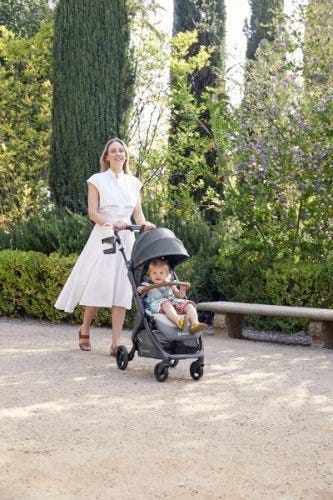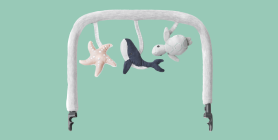
When my little one was ready for solid foods I decided to use the baby-led weaning approach. In this method finger foods are introduced right from the start and purees are skipped altogether. It was a fantastic fit for my family and I believe it really helped our son establish healthy eating habits. He’s almost 2 years old now and has a fantastic appetite with an impressively adventurous palate. Here are some reasons that we love about baby-led weaning.
Experiencing & exploring foods
Babies love the opportunity to interact with food! If spoon-feeding, there are still some approaches from baby-led weaning that help engage baby in mealtime. Babies often spit out puree and try to grab it with their hands. That's because they're curious and want to be involved, but parents are usually quick to wipe it up or scoop it back into baby's mouth. Try putting a small spoonful of puree on your baby’s tray for them to touch & taste on their own before you begin feeding - and again if changing flavors. This gives them a chance to become familiar with what they're consuming and allows them to explore different textures, colors & flavors.
Helps improve manual dexterity
Finger foods at an early age are great for helping baby develop their hand eye coordination. It’s best to refrain from helping your baby get the food to their mouth. It may be tempting when you see them struggle, but they are developing their skills and must learn on their own. It is also much safer if baby is in full control of everything that goes in and out of their mouths.
Family meal time
Babies want to imitate adults and they learn various skills (social & developmental) from being a part of family mealtimes. We also found a bonus as parents - meals became a relaxing time for us to connect in conversation at the dinner table. With spoon-feeding, usually one parent feeds baby as the other parent eats. With baby-led weaning, baby eats while you eat so it’s a great time to sit together and catch up at the end of the day.
Encourages healthy appetite control
A breastfed baby has control of how much they consume at each feeding, so why do we take this power away once solids are introduced? Try not to convince your baby to have "just one more bite”. This can be especially tempting with single serve purées. Trying to get babies to eat more than they are inclined can cause them to become disconnected with their own cues of hunger and satiation - something that most adults suffer from.
Less complicated meals with no mealtime battles
No need for convincing tricks or ‘here comes the airplane”. Baby-led weaning allows your baby to choose what and how much to eat. If they won't eat anymore, take a break and try again when they might be more receptive. Some days they'll eat more, some days they'll eat less. Your job as a parent is just to offer healthy choices at regular intervals, but it's up to them to eat. Giving them the power to decide means that control issues are less likely to develop. They’ll also become more open to trying new things and it can greatly reduce pickiness as a toddler.
Baby-led weaning allows your little one to see that different foods have unique shapes & textures versus pureed food, which has different flavors, but are always the same texture. Imagine if someone was hand-feeding you grapes and then suddenly slipped an olive in your mouth without warning. Even if you like olives, you might be a little weary of the person feeding you after that. Whether using baby-lead weaning, purees or a combination, understanding how to ‘let baby lead’ is crucial for helping them establish healthy eating habits right from the beginning. My program, (Baby Knows Best: An Intro To First Foods) covers all methods of solid introduction and will allow you to make an educated decision about the method that feels right for you and your family.
Emotional Benefits of Getting Outside
Spending time in nature with your baby can strengthen the bond between you. The simple act of holding your baby close, feeling their warmth, and sharing new experiences together can create strong emotional connections. It’s also a wonderful way to reduce stress and improve your mood. When my littles were extra fussy, I’d take a walk around the neighborhood. Even though I don't live in an area with trails and surrounded by nature, simply behind outside changed everything. A little vitamin D does wonders!
Cognitive Development
Nature is a sensory wonderland for babies. The different sights, sounds, and smells can stimulate your baby’s senses and promote cognitive development. Watching leaves rustle, hearing birds chirp, and feeling the texture of a tree bark can all contribute to their learning and development.
All About Baby Carriers for Nature Adventures
Choosing the Right Baby Carrier
When it comes to selecting the best baby carrier for summer adventures, there are several options to consider.
Types of Baby Carriers:
- Wraps: Perfect for newborns, providing a snug and secure fit.
- Slings: Ideal for quick and easy use, offering good ventilation.
- Soft Structured Carriers: Versatile and comfortable for both parent and baby, suitable for longer trips.
Factors to Consider:
- Baby’s Age and Weight: Ensure the carrier is appropriate for your baby’s size and weight. For example, Ergobaby’s Embrace Newborn Carrier is perfect for the fourth trimester where baby is small and you’re looking for an easy way to stay close. As they grow, you’ll want to upgrade to an all-position carrier that’s meant for growing babies.
- Parent’s Comfort and Ergonomics: Look for carriers with padded shoulder straps and lumbar support if you’re planning on longer outings.
- Ease of Use: Choose a carrier that is easy to put on and take off.
- Climate and Breathability: Opt for carriers made of breathable fabrics to keep you and your baby cool in hot weather.
Safety Tips:
- Proper Positioning: Ensure your baby is seated correctly, with their legs in an "M" position and their head should be close enough to kiss.
- Checking for Wear and Tear: Regularly inspect your carrier for any signs of damage.
- Ensuring Adequate Support: Make sure the carrier provides proper support for your baby’s head and neck.
Exploring Nature with a Baby Carrier
Ideal Spots for a Nature Walk with Baby
- Parks and Gardens: Great for leisurely walks and picnics.
- Nature Trails and Forests: Perfect for more adventurous outings.
- Beaches and Lakesides: Wonderful for enjoying the water and sand, with the right carrier.
Activity Ideas
- Hiking: Enjoy a scenic hike with a hiking baby carrier that offers support and storage.
- Bird Watching: Use your carrier to keep your baby close while you explore and observe wildlife.
- Picnics: A carrier can free up your hands, making it easier to carry picnic supplies.


Advantages of Using Strollers for Nature Adventures


While baby carriers are fantastic for mobility and closeness, depending on the adventure of choice you might want to be a stroller along too.
There are a LOT of baby stroller options on the market. So we understand how confusing it can be to choose the one that’s right for your family. Not only are there a variety of brands, but a variety of strollers that serve different purposes.
There are a few types of strollers on the market:
- Full-sized stroller: This is typically the stroller parents thing of buying for all its versatility.
- Lightweight or umbrella stroller:These compact strollers are perfect for on-the-go adventures.
- Jogging stroller: Designed for parents who want to combine fitness with outdoor adventures.
- Double stroller: Designed for parents with multiple kids, especially twins.
- Car seat carrier: These strollers connect to a specific car seat. We don't typically recommend these as they can be unsafe for baby and uncomfortable for parents who are pushing.
Learn more about the types of strollers and which one would be best for you.
Benefits of Bringing a Stroller
- Storage Space for Gear: Ample room for carrying all your essentials like a diaper bag, beach toys and more.
- Shade and Weather Protection: Built-in canopies to shield your baby from the sun when they are lounging.
- Options: If you have more than one kid, you can stroll with one and carry the other. Or, if you’re getting warm or your little one is getting fussy, you can switch up their position from stroller to carrier or vice versa.
Safety Tips for Strollers
- Ensure your stroller is in good working condition. Make sure buckles are still buckling and that there are no rips or holes that could compromise your baby’s safety.
- Use sunshades or bug nets to protect your little one’s skin.
- Securing the baby properly: always buckle up your baby for safety even if you think they are old enough to go without the buckle.
Combining Baby Carriers and Strollers
For the ultimate flexibility, consider using both a baby carrier and a stroller on your outings.
Combining both options allows you to adapt to different situations. Use the carrier for more rugged trails and switch to the stroller for smoother paths or when your baby needs a nap.
Transition Tips
- Smooth Transitions: Plan stops where you can easily switch from carrier to stroller.
- Pack Light: Only bring essentials to make transitions easier.
Tips for a Successful Adventure
Planning Ahead
- Route Planning: Choose baby-friendly trails and parks. Check local mom groups or outdoor groups and get recommendations for the best outings for kids.
- Check Weather Conditions: Avoid extreme heat or unpredictable weather. Even with our most breathable carriers, when it’s hot, it’s hot. And having two bodies against each other in the heat will be naturally hot and sticky already.
- Packing Checklist: Include diapers, snacks, water, sunscreen, and a first-aid kit. These all-position carriers have storage pockets where you can fit some of the items easily!
- Stay Hydrated and Nourished: Pack healthy snacks to keep energy levels up and bring plenty of water for both you and baby.


Summer adventures with your baby are a wonderful way to create lasting memories and enjoy the beauty of nature together. From baby carriers to strollers, Ergobaby products are designed to provide comfort and ease for both you and your little one. So, gear up, get outside, and explore the world with your baby by your side.
Ready to embark on your own summer adventures? Check out Ergobaby’s range of baby carriers and strollers to find the perfect match for your family’s needs. Visit our website today and start planning your next outdoor excursion!



























